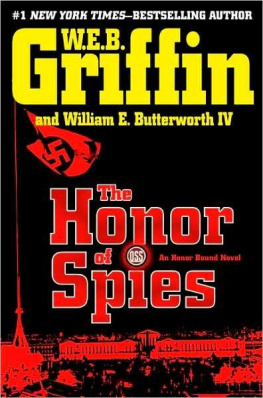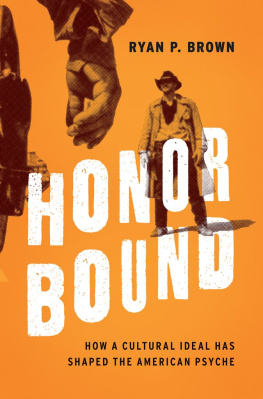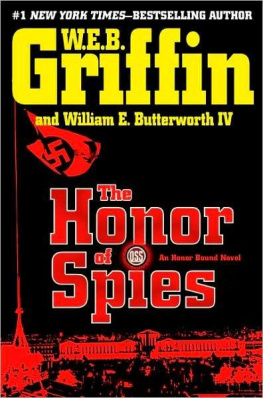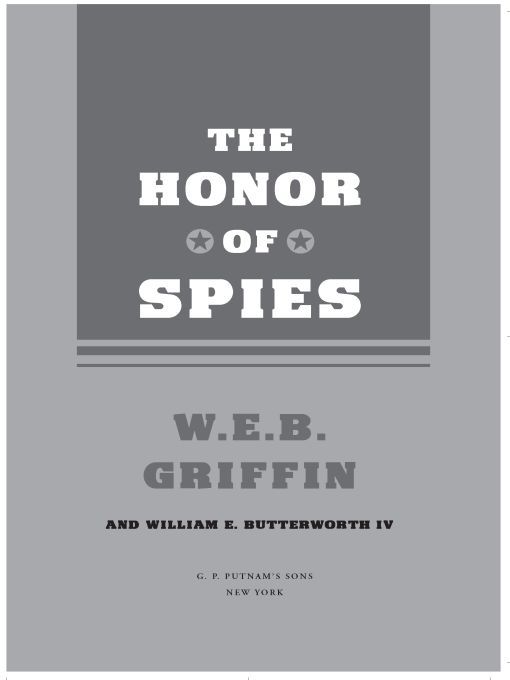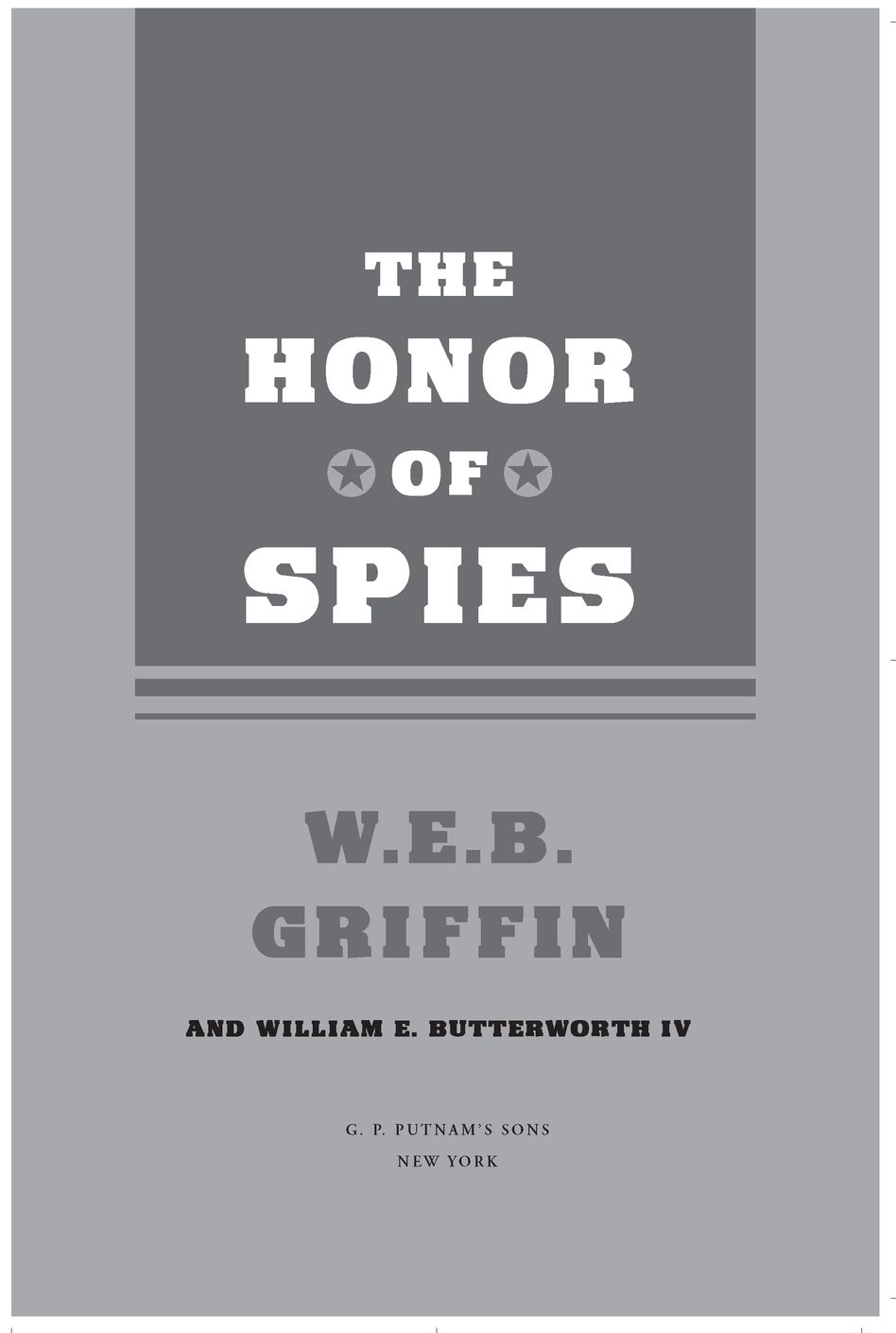Table of Contents
ALSO BY W.E.B. GRIFFIN
HONOR BOUND
HONOR BOUND
BLOOD AND HONOR
SECRET HONOR
DEATH AND HONOR
(and William E. Butterworth IV)
BROTHERHOOD OF WAR
BOOK I: THE LIEUTENANTS
BOOK II: THE CAPTAINS
BOOK III: THE MAJORS
BOOK IV: THE COLONELS
BOOK V: THE BERETS
BOOK VI: THE GENERALS
BOOK VII: THE NEW BREED
BOOK VIII: THE AVIATORS
BOOK IX: SPECIAL OPS
THE CORPS
BOOK I: SEMPER FI
BOOK II: CALL TO ARMS
BOOK III: COUNTERATTACK
BOOK IV: BATTLEGROUND
BOOK V: LINE OF FIRE
BOOK VI: CLOSE COMBAT
BOOK VII: BEHIND THE LINES
BOOK VIII: IN DANGERS PATH
BOOK IX: UNDER FIRE
BOOK X: RETREAT, HELL!
BADGE OF HONOR
BOOK I: MEN IN BLUE
BOOK II: SPECIAL OPERATIONS
BOOK III: THE VICTIM
BOOK IV: THE WITNESS
BOOK V: THE ASSASSIN
BOOK VI: THE MURDERERS
BOOK VII: THE INVESTIGATORS
BOOK VIII: FINAL JUSTICE
BOOK IX: THE TRAFFICKERS
(and William E. Butterworth IV)
MEN AT WAR
BOOK I: THE LAST HEROES
BOOK II: THE SECRET WARRIORS
BOOK III: THE SOLDIER SPIES
BOOK IV: THE FIGHTING AGENTS
BOOK V: THE SABOTEURS
(and William E. Butterworth IV)
BOOK VI: THE DOUBLE AGENTS
(and William E. Butterworth IV)
PRESIDENTIAL AGENT
BOOK I: BY ORDER OF THE
PRESIDENT
BOOK II: THE HOSTAGE
BOOK III: THE HUNTERS
BOOK IV: THE SHOOTERS
BOOK V: BLACK OPS
IN LOVING MEMORY OF
Colonel Jos Manuel Menndez,
Cavalry, Argentine Army, Retired
He spent his life fighting Communism and Juan Domingo Pern.
PROLOGUE
By August 1943, the United States of America had been in the Second World War for twenty months.
England had been at war for four years, since 1 September 1939, whena week after German leader Adolf Hitler signed a non-aggression treaty with the Soviet UnionGermany launched its Blitzkrieg (Lightning War) against Poland.
England and France declared war.
By 6 October 1939, Poland had fallen and was divided between the Soviet Union and Germany. The Phony War followed, with the belligerents taking littlevirtually noaction against each other.
One significant exception to this occurred two months later, when, on 13 December 1939, Royal Navy cruisers engaged the German pocket battleship Admiral Graf Spee off the Atlantic coast of South America and forced the damaged ship to seek refuge in Montevideo, Uruguay.
Diplomatic pressure (largely from the United States, although this was denied at the time) on Uruguay forced that small country to insist on following international law, which required belligerent vessels to leave sanctuary ports within seventy-two hours. On 17 December, Captain Hans Langsdorff, to save further loss of life in a battle he knew he could not win, scuttled the Graf Spee just outside the mouth of the Montevideo harbor. He then went to Argentina, buried his dead, made arrangements for the internment of his crewand then shot himself in the temple, arranging that event so his body would fall on the German navy battle flag.
The Phony War turned real on the night of 9/10 May 1940, when the Germans occupied Luxembourg and launched another Blitzkrieg, this time into the Netherlands and Belgium. The Dutch surrendered 15 May.
On 5 June 1940, the Germans solved the problem of the impregnable French Maginot Line of fortresses by going around them. Paris fell on 14 June. Not all French were desolated; substantial numbers of them embraced the motto Better Hitler Than Blum. Andr Lon Blum, a socialist, already had twice served as Frances prime minister.
The French capitulated on 25 June 1940.
The only good news for the English during this period was their brilliant evacuation of 300,000 British soldiers and some 38,000 French from Dunkirk.
Germany began a massive aerial bombardment of England as the prelude to a cross-Channel invasion. The Royal Air Forces valiant and effective defense of Enland caused Winston Churchill, its prime minister, to utter the famous line Never in the field of human conflict was so much owed by so many to so few.
The severe losses suffered by the Luftwaffe are cited by some historians as the reason Adolf Hitler called off the invasion. Other historians feel that it was Hitlers decision to stab the Soviet Union in the back that brought him to that decision. He would deal with the English after he had dealt with the Communists.
The backstabbingOperation Barbarossa, named in honor of Frederick I, Holy Roman Emperorwas the largest attack of the Second World War, and initially the most successful. It began on 22 June 1941.
It was brilliantly planned, brilliantly executed, and took the Russians entirely by surprise.
On 15 September, German forces began the siege of Leningrad. Theyand almost everyone elsethought it would be over in about a month. With that in mind, the Germans on 2 October 1941 began their march on Moscow and soon the gilded tops of the Soviet capitals churches could be seen through German binoculars.
Before things (including the weather and Soviet tenacity) turned against them, the Germans held 750,000 square miles and had nearly 100 million people under their boot.
On 5 December, the attack on Moscow was called off. Winter had set in, and the Germans were simply unprepared to fight in the terrible cold. The troops were freezing and could not be properly supplied. Moscow could wait until spring.
Two days later7 December 1941, a date President Franklin D. Roosevelt declared would live in infamythe Japanese attacked the U.S. Navy base at Pearl Harbor, Territory of Hawaii. That, too, was a brilliant operation, one meticulously planned, effectively carried out, and which took the Americans by complete surprise. When it was over, most American battleships in the Pacific were at the bottom of Pearl Harbor.
And things promptly got worse.
On 11 December, Germany and Italy declared war on the United States. On Christmas Day 1941, Japan took Hong Kong, and on 2 January 1942, Manila was declared an open city and fell to the Japanese.
With the fall of all the Philippines to the Japanese only a matter of time, and aware that the morale of the American people was as low as it had ever beenand sinkingPresident Roosevelt authorized a near-suicidal bombing attack on Japan.
On 18 April 1942, Lieutenant Colonel Jimmy Doolittle led a small flight of B-25 Mitchell bombers from the deck of an aircraft carrier to Tokyo. The physical damage they caused was minimal, but the damage to Japanese pride was enormous. And the United States could finally claim to be fighting back.
Eighteen days later, on 6 May 1942, Lieutenant General Jonathan M. Wain-wright surrendered the Philippines to the Japanese. It was the largest surrender in U.S. history.
Japan was now poised to invade Australia from bases in the Solomon Islands. But on 7 August 1942, the just-formed U.S. First Marine Division, which was not supposed to be ready to fight for a year, was thrust into the breach and landed on Guadalcanal.


